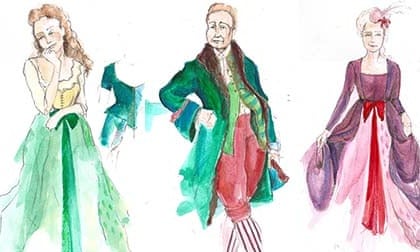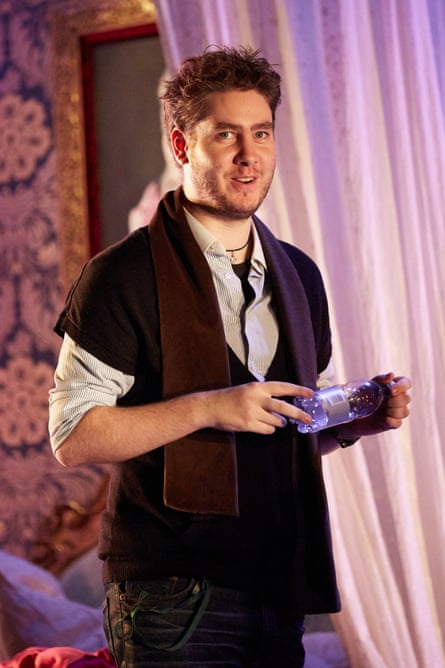week zero
Today is our first production rehearsal - in a ballet studio. The first performers arrive promptly, while veterans of the past season linger in the staff café over their morning coffee - they know to wait until the second call sounds over the tannoy that reaches into every corner of the opera house. Our set arrives next week: for now we have chairs and tables standing in for the real thing. It’s a nice thought that sometimes the Royal Opera House and the church hall rehearsal venues back home in Melbourne aren’t that dissimilar.
For the past six months, I’ve been working and re-working scenarios for my production of Rossini’s La scala di seta (the Silken Ladder) in my head, trying to create a world which I believe will tell the story both truthfully and honestly (which sound like the same thing, but are really worlds apart). I know that the images that are still in my head will soon be forever replaced by the reality of the rehearsal room and that in many (most?) cases the end result will be much more nuanced, detailed, and complex than I had been able to craft in my imagination. But, as experience has taught me, there will always be a scene, a stage-picture perhaps, or an actor’s intention whose loss I’ll mourn once we get to the stage. I wonder which it will be this time.

Designer Holly Pigott and I have spent much of the past few months shooting emails back and forward, meeting for coffees to discuss what we think of characters and how best to show their world and their struggles. We’ve been through a hundred bad ideas (mainly mine), but with a budget this tight we’ve slowly stripped away everything that was a “maybe” and now we’re left with just a kernel, a concentration of the essential elements. Meanwhile the past two weeks have been a series of informal “coachings” - an opportunity to work closely on text with the performers, away from the distraction (!) of the musical notes, and join with the singers to try and make sense of the story, the characters and the impulses that drive both along.
Everyone’s arrived. The clock on the back wall has clicked over to 10.30 and it’s time to begin. Deep breath.
Week one
And so, the (short) first week comes to an end. We’ve been working quickly, making rough stage shapes and then ploughing through scenes. My hope is that we’ll all get a feel of the work’s natural ebb and flow and have covered everything by the end of next week. It’s a tall order to stage an entire opera in eight days, but this pace is necessary if we’re to make the most of our limited time on the set on the Linbury stage. It’s just one of the challenges of the job!
As a text-based director, I like to start the rehearsal with everyone around the piano going through each line so we all know what’s going on. It’s clear that some of the performers have done a lot of homework, but I hope that everything is learnt fully by next week – we can’t begin to discuss subtle dramatic nuances until the dots have been memorised. We’re lucky with conductor Jonathan Santagada – he has a real ear for the drama and is happy to let us experiment musically in search of the truth of a scene. Let us hope I don’t use up all the goodwill too soon! I am itching now to see the complete set in the rehearsal room for the first time – next week can’t come soon enough.

Week two
To paraphrase Dinah Washington “What a diff’rence a set makes”. Although ours is quite simple (compared to the large-scale worlds of the mainstage), in the larger opera rehearsal room we’ve been able to see clearly its size and geography and adjust our staging accordingly. I’m still a bit concerned about some of the performers – while it’s of course vital to know what you’re singing, it’s equally important to know what other people are singing to, and about, you. In this respect, we’re helped greatly by language coach Matteo dalle Fratte who sits perched on conductor Jonathan Santagada’s left-hand side with the score, ready to spring forward with notes when we stop a scene. More than just a native Italian speaker, Matteo is a musicologist and knows how the performers should best achieve the delicate balance between pronunciation and physically shaping the words on the correct pitch. This week has also seen our climbing specialist Philip d’Orleans advise us on the correct and safest way to climb up and down at height – the opera revolves around adventurous young men ascending the silk ladder of the work’s title into Giulia’s bedroom. We’ve been able to do a complete a run of Act One. Although not perfect, there are many good moments, and I now know where I need to shift my focus for next week’s rehearsals.
Week three
I write this in a spirit of disappointment after a difficult rehearsal. This week we’ve been working closely with movement director Jo Meredith to refine gestures and the quality of movements. It is a very difficult job being a singer – at any time you can get notes from the conductor, director, movement director, music staff, repetiteur, language coach – but it is the bringing together of all these elements that must happen if you are to create a believable world. We have all worked hard, and when I see notes being forgotten I reserve my greatest disappointment for myself – it is my job to communicate effectively with the performers - however it’s clear from this afternoon’s rehearsal that I’m yet to achieve that with some. My weekend will consist of trying to refine and distil my notes so that they might be better taken on by the performers. Let us hope that next week ends on a more optimistic note.

Week four
We’ve now rehearsed for the equivalent of 16 days and we’re ready for the stage - and all the crises that will emerge once we throw lights, costumes and an orchestra into the mix! The final studio run yesterday was a great success - there’s still room for improvement but by-and-large we’re there. The shapes are strong and feel organic, the thoughts are clear and getting clearer, the singing has improved as a result of the growing stamina of the singers (singing Rossini all day every day is quite a workout!). Stage management led by the wonderful Jack Stookes have re-affirmed their reputation as the hardest working people at the Opera House by virtue of the slew of documents they have prepared – Entry & Exit Plots, Prop Plots, Lists of Cues for Performers, Preliminary Lighting Cues, Risk Assessments and others. The set will be installed over the weekend. (An antipodean fact - while in the UK this process is called the “Get-in”, in Australia it’s called the “Bump-in”!) I’ve just returned from the sitzprobe (conductor Jonathan Santagada rehearsing the singers and the orchestra) and was surprised at some of the tempi – some a great deal faster than in the studio with the piano. I’ll have to prepare a Plan B in case we have to adjust blocking to reflect these differences. Until then, I’m preparing to spend all day in the theatre tomorrow watching everything being brought in; there’s something magical about sitting in an empty, darkened auditorium watching a show being born…
La scala di seta by Rossini performed by the Jette Parker Young Artists is at the Linbury Studio Theatre, Royal Opera House, London on 23 (7pm) and 24 October (1pm and 7pm).
